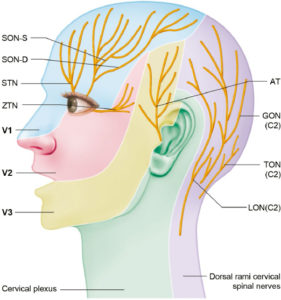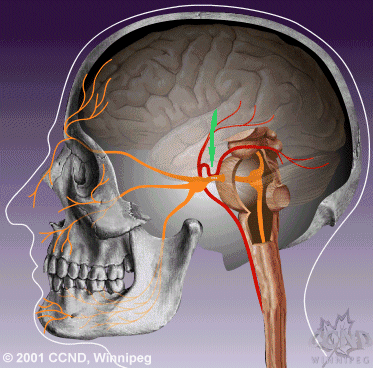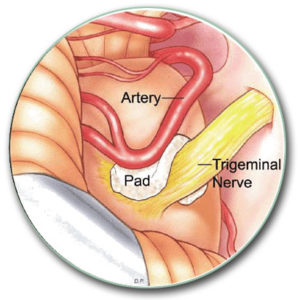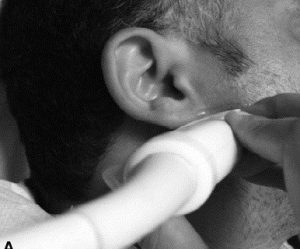Zeljko Kojadinovic, MD- Neurosurgeon and Pain Specialist
Trigeminal neuralgia manifests as facial pain. There are many types of trigeminal neuralgia: typical, atypical, pre-neuralgia, post-traumatic, secondary, neuralgia in multiple sclerosis and neuralgia resistant to classic treatment. It is important from the beginning to distinguish what type it is because the treatment of each differs a lot. In addition to this, there are numerous other syndromes that are manifested by facial pain and it is necessary to distinguish them from trigeminal neuralgia.
Trigeminal neuralgia – typical
Trigeminal neuralgia – typical is pain in the face or mouth that occurs suddenly, is of great intensity, and usually lasts usually up to one minute. Usually, it attacks people older than 50 years of age, predominately females. Patients often describe this pain as an electric shock, sharp stabbing, etc. Pain is usually located on one side. It can be provoked by touch or other mild stimuli of certain parts of the face or mouth (These are the so-called trigger zones). In typical primary neuralgia, at the beginning, there are no symptoms between attacks of pain, and the neurological examination reveals nothing. This finding is already sufficient for diagnosis.


In addition to examination, an MRI scan of the brain must be done to determine if there is a possible illness causing the trigeminal neuralgia, in which case it is called secondary neuralgia. This may be a tumor, multiple sclerosis, aneurysm, dental problems, etc.
The cause of typical trigeminal neuralgia is often the pressure of a blood vessel on the trigeminal nerve inside the scull, as shown in the picture. That pressure causes degenerative changes in the origin of the trigeminal nerve from the brainstem. Other types of trigeminal neuralgia are not caused by this type and location of nerve damage and irritation.

The treatment always starts with oral medications. Carbamazepine is most commonly used (Tegretol, Carbatrol, Epitol, Equetro).
Over time, the drugs’ effect seems to weaken, and the pain becomes more frequent and longer-lasting. Many patients suffer pain practically all day long. Because drugs do not help, and they do not choose to undergo interventions, these people have often been suffering terribly for years when they contact us for a consultation. During consultation, what is most important is to get all information about the pain and other symptoms. Analyzing this information allows us to determine the exact location and type of irritation of the trigeminal nerve. CT and MRI scans alone are not enough to achieve this. When this is determined, an adequate combination and dosages of oral medications and other advice can be prescribed. This treatment is always individual. Through this approach it is possible to achieve an excellent result in over 80% of cases. Online consultation link
There are several types of surgical treatment:
Surgery- Microvascular decompression (MVD)- A minimal opening of the skull behind the ear and removal of any pressure on the trigeminal nerve. This method shows excellent and long-term results in 80% of cases. The intervention takes about 2 hours and is tolerated excellently even by patients over the age of 70.

In older people who are not candidates for general anesthesia, another intervention is recommended. The purpose is to destroy the painful fibers in the part of the trigeminal nerve called the ganglion (Gasser’s ganglion). Destruction is performed by elevated temperature at the tip of a needle. The needle is introduced over the skin of the face, assisted by a special apparatus for heating the tip of the needle. This method is not as successful as the previous one.
In recent times, better results than the previous method are achieved by localized precise radiation of the trigeminal nerve – the entry of the trigeminal nerve in the brainstem or the middle of the nerve – Gamma Knife radiosurgery.
In very old people, with a life expectancy of less than two years, some doctors opt for destruction of the nerve in the face. This method does not have good long-term results, and recurrent pain can reappear after 1 to3 years. Then it can be even stronger pain (deafferentation pain).
Alternative treatment includes acupuncture, chiropraxis.
Atypical trigeminal neuralgia
Atypical trigeminal neuralgia has the following characteristics: it usually starts in younger patients, the pain is more frequent from the begining, usually there is face numbness, and it is more resistant to classic medications.
In the case of so-called atypical trigeminal neuralgias, operations and the usual drugs do not give satisfactory results. In the treatment of atypical neuralgia, it is important to detect the location and type of trigeminal nerve iritation. Then a specific combination of medications can be prescribed. Reductuion of the pain in a few days can be expected in 80% of patients. Also interventional pain treatments are successfull. By our approach, we can do this and tailor the combination of modern medications specific just for you. Contact us for a consultation.

There are also neuralgias of other nerves (glossopharyngeal neuralgia, sphenopalatine neuralgia). Their treatment also starts with oral medication. If they do not reduce the pain enough, they are then treated surgically very successfully.
More information about trigeminal neuralgia – here

